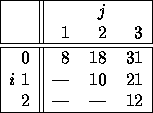
Figure 11.1: Phone Network
Consider a phone network. At any given time, a message may take a certain amount of time to traverse each line (due to congestion effects, switching delays, and so on). This time can vary greatly minute by minute and telecommunication companies spend a lot of time and money tracking these delays and communicating these delays throughout the system. Assuming a centralized switcher knows these delays, there remains the problem of routing a call so as to minimize the delays. So, in figure 11.1, what is the least delay path from LA to Boston? How can we find that path quickly?
This is an example of a particular type of network model, called the shortest path problem. In such a problem, you have a network with costs on the edges and two special nodes: a start node and a finish node. The goal is to find a path from the start node to the finish node whose total weight is minimized.
Here is another problem that might not appear to be a shortest path problem, but really is:
At a small but growing airport, the local airline company is purchasing a new tractor for a tractor-trailer train to bring luggage to and from the airplanes. A new mechanized luggage system will be installed in 3 years, so the tractor will not be needed after that. However, because it will receive heavy use, and maintenance costs are high, it may still be more economical to replace the tractor after 1 or 2 years. The following table gives the total net discounted cost associated with purchasing a tractor in year i and trading it in in year j (where year 0 is now):

The problem is to determine at what times the tractor should be replaced (if ever) to minimize the total costs for tractors. How can this be formulated as a shortest path problem?